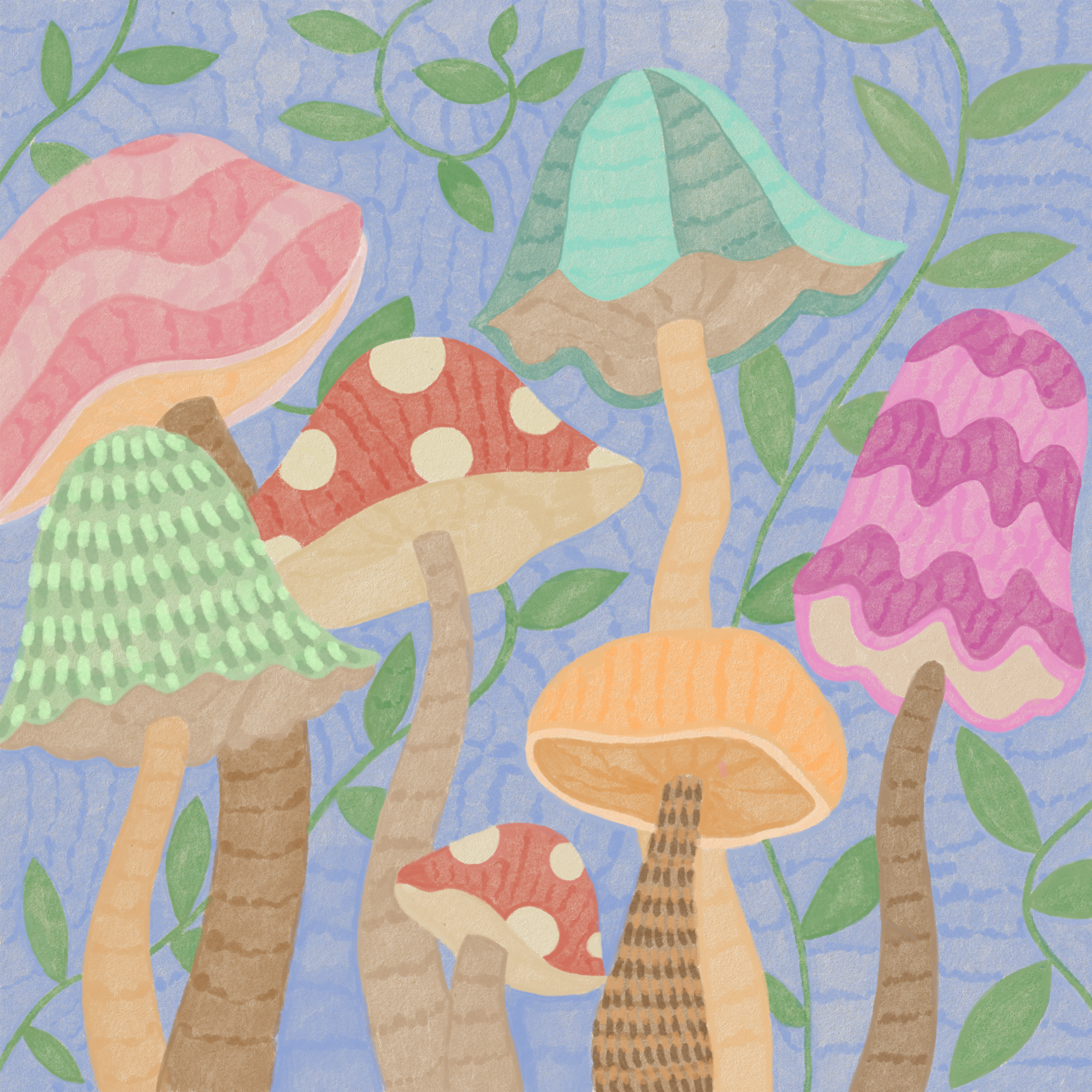
Delve into the connection between humans and mushrooms, exploring their shared ancestry and therapeutic potential. Science has finally caught up to ancient anecdotal evidence of the healing properties. Psilocybin mushrooms offer a unique journey into consciousness, emphasising the need for mindful engagement. Indigenous wisdom guides a holistic approach, urging respect for these ancient teachers in our quest for well-being.
Delve into the connection between humans and mushrooms, exploring their shared ancestry and therapeutic potential. Science has finally caught up to ancient anecdotal evidence of the healing properties. Psilocybin mushrooms offer a unique journey into consciousness, emphasising the need for mindful engagement. Indigenous wisdom guides a holistic approach, urging respect for these ancient teachers in our quest for well-being.

Illustration by Arianna Cavalli

Illustration by Arianna Cavalli
Let’s rekindle the harmony with our long-lost ancestors, fungi. The shared ancestry comes to light in our resemblance. Their delicate mycelial network intricately weaves through forests, mirroring the convoluted neuronal network of the human brain. Just as the synaptic connections in our minds communicate to breathe consciousness into our existence, the fungal kingdom serves as a forest’s collective mind, echoing the interconnected nature of our thoughts. It’s as if Mother Nature drew from the same artful conception of fungi as the human mind. Unfortunately, our conceptualisation of fungi is limited to simple decomposers or stigmatised for their psychoactive variants. Yet, there’s so much more to these fungi than meets the eye. Fungi can bring us back to nature as potential contributors to medicine, inviting us to explore their therapeutic possibilities.
Let’s begin with the intertwined history between fungi and humans. The use of medicinal mushrooms dates back to antiquity. In Asian cultures, Reishi has been used in medicine for over 2,000 years. Chinese healers called it the “herb of spiritual potency” during the Han dynasty. (Wachtel-Galor et al., 2011). In ancient Greece, a drink called kykeon was used in religious rituals. Kykeon contained a psychoactive ingredient, possibly ergot, believed to induce altered states of consciousness that allowed communication with the gods (Hellenic Museum, 2021). The interwoven presence of medicinal mushrooms in various historical periods and cultures reflects an old bond between humanity and the profound spiritual dimensions of mushrooms.
The health benefits of mushrooms are rooted in anecdotal evidence, traditional use, and cultural practices. Contemporary scientific studies are beginning to support the longstanding claims, bridging the gap between historical perspectives and scientific understanding. The research aims to investigate neurotrophic and neuroprotective properties. Neurotrophic agents promote neurons’ growth, development, and maintenance, while neuroprotective ones shield neurons from damage, degeneration, or injury. So, how do mushrooms support and protect the intricate workings of the brain?
“The interwoven presence of medicinal mushrooms in various historical periods and cultures reflects an old bond between humanity and the profound spiritual dimensions of mushrooms.”
Out of all the mushrooms, the Lion’s Mane captivates scientific attention. The mushroom compounds involved in neural health are hericenones and erinacines (Kim et al., 2014). Hericenones stimulate nerve growth factors (NGF) and mimic the effects of NGF, leading to improved cognitive function. On the other hand, erinacines have been found to show neuroprotective effects by counteracting neuro-inflammation processes that are associated with cell death and cognitive impairment. Their anti-inflammatory properties have shown promising results in the fight against age-related cognitive decline. The Lion’s Mane mushroom casts a shimmering light of hope against neurodegeneration with its combination of neurotrophic and neuroprotective effects.
Not to mention, clinical studies have found a promising impact on mental disorders. The studies found that the consumption of Lion’s Mane alleviated symptoms of depression and anxiety (Chong et al., 2019). However, the precise mechanisms through which the compounds relieve symptoms remain unclear. Nevertheless, this research offers a potential alternative without the adverse side effects commonly associated with conventional antidepressants.
As research highlights the fascinating neural effects of mushrooms, let’s explore another unique aspect of fungi that takes us on a distinct journey into the mind: psilocybin mushrooms. Psychedelics loosen the control of the cortical regions and thus facilitate the flow of information that comes from the subcortical areas. The interplay enriches conscious experience, fostering the emergence of new insight and potential therapeutic and healing effects. Think of the brain like an orchestra, where the conductor (cortical regions) usually controls the music based on existing beliefs. Psychedelics let the musicians (subcortical areas) play more freely. This burst of freedom allows new tunes—representing memories, emotions, and sensations—to mix in, creating a richer symphony of experiences and unlocking a hidden beauty in the mind’s concert, offering fresh insights.
In theory, it is consciousness-expanding; in practice, it is mind-changing. Current research on psilocybin use is complex due to criminalisation. Thus, studies mainly constitute reported microdosing, which involves consuming minimal, sub-hallucinogenic amounts of psilocybin mushrooms. Microdosing yields mixed effects, with positive outcomes like improved mood, enhanced connectedness, and cognitive enhancement, but potential drawbacks like unexpected intense psychedelic experiences and paranoia, albeit rarely reported (Lea et al., 2020). Cognitive benefits include increased divergent thinking and a perceived slowing of time, fostering cognitive flexibility and mindfulness. Such effects could combat ruminative thinking and promote self-compassion, potentially reducing symptoms of depression (Kuypers, 2020). Microdosing psychedelics presents various mental health benefits, yet it demands a mindful approach. Expectation effects may influence reported benefits (Cavanna et al., 2022). People use harm-reduction practices in a conscientious effort to mitigate potential risks.
“In theory, it is consciousness-expanding; in practice, it is mind-changing.”
Williams et al. (2022) discuss indigenous philosophies and the “psychedelic renaissance”. Mazatec shamans use psychoactive mushrooms in their healing rituals to tap into the power and wisdom of the land. Indigenous communities stress the importance of recognising the connection between plants and humans beyond merely obtaining knowledge from transcendent realms through psychedelics, promoting more holistic and respectful connections. Unfortunately, the neocolonisation of psychedelics has led to biopiracy, cultural appropriation, and a lack of recognition of Indigenous Knowledge.
In navigating the psychedelic renaissance and honouring Indigenous people, the authors advise re-evaluating relationships with sacred medicines for more respectful connections and a deeper understanding of human-nature interconnectedness. They highlight engaging with Indigenous leaders for insights into the psychedelic sphere. Supporting the Land Back movement is crucial for decolonisation. The authors stress the need for cross-cultural discussions on international intellectual property rights regarding Indigenous knowledge of psychedelic plants and fungi. This approach addresses appropriation issues and ensures equitable knowledge sharing in psychedelic research.
The deep relationship between humans and fungi, spanning shared ancestry, invites us to reconsider the significance of mushrooms in our lives. One should engage with mushrooms mindfully and respectfully to better understand their therapeutic potential and the interconnectedness between nature and human consciousness. But most of all, remember where and with whom these sacred practices originate. <<
References
– Beresford, D. (2019, May 6). Exploring The Underground Network of Trees – The Nervous System of the Forest – Science in the News. Science in the News. Retrieved December 5, 2023, from https://sitn.hms.harvard.edu/flash/2019/exploring-the-underground-network-of-trees-the-nervous-system-of-the-forest/
– Carhart-Harris, R. L., & Friston, K. J. (2019). REBUS and the Anarchic Brain: Toward a Unified Model of the Brain Action of Psychedelics. Pharmacological Reviews, 71(3), 316-344. 10.1124/pr.118.017160
– Cavanna, F., Muller, S., de la Fuente, L. A., Zamberlan, F., Palmucci, M., Janeckova, L., Kuchar, M., Pallavicini, C., & Tagliazucchi, E. (2022). Microdosing with psilocybin mushrooms: A double-blind placebo-controlled study. Translational Psychiatry, 12(1), 307. 10.1038/s41398-022-02039-0
– Chong, P. S., Fung, M.-L., Wong, K. H., & Lim, L. W. (2019). Therapeutic potential of hericium erinaceus for depressive disorder. International Journal of Molecular Sciences, 21, 163. 10.3390/ijms21010163
– Estrada, A. (1989). Vida de María Sabina: la sabia de los hongos. Siglo Veintiuno Editores.
– Gattuso, J. J., Perkins, D., Ruffell, S., Laurence, A. J., Hoyer, D., Jacobson, L. H., Timmermann, C., Castle, D., Rossell, S. L., Downey, L. A., Pagni, B. A., Galvão-Coelho, N. L., Nutt, D., & Sarris, J. (2022). Default Mode Network Modulation by Psychedelics: A Systematic Review. International Journal of Neuropsychopharmacology, 26(3), 155–188. 10.1093/ijnp/pyac074
– Hellenic Museum. (2021, September 6). Ritual & Religious Drug Use in Ancient Greece. Hellenic Museum. Retrieved December 5, 2023, from https://www.hellenic.org.au/post/ritual-religious-drug-use-in-ancient-greece
– Kim, Y. O., Lee, S. W., & Kim, J. S. (2014). A comprehensive review of the therapeutic effects of Hericium erinaceus in neurodegenerative disease. Journal of Mushrooms, 12(2), 77-81. 10.14480/jm.2014.12.2.77
– Kuypers, K. P.C. (2020). The therapeutic potential of microdosing psychedelics in depression. Therapeutic Advances in Psychopharmacology, 10, 1-15. o0i.o.r1g1/170.711/77/2045125320950567
– Lea, T., Amada, N., Jungaberle, H., Schecke, H., & Klein, M. (2020). Microdosing psychedelics: Motivations, subjective effects and harm reduction. International Journal of Drug Policy, 75, 102600. 10.1016/j.drugpo.2019.11.008
– Lyes, M., Yang, K. H., Castellanos, J., & Furnish, T. (2022). Microdosing psilocybin for chronic pain: A case series. Pain, 164(4), 698-702. 10.1097/j.pain.0000000000002778
– Phan, C.-W., David, P., Naidu, M., Wong, K.-H., & Sabaratnam, V. (2014). Therapeutic potential of culinary-medicinal mushrooms for the management of neurodegenerative diseases: Diversity, metabolite, and mechanism. Critical Reviews in Biotechnology, 35(3), 355-368. 10.3109/07388551.2014.887649
– Wachtel-Galor, S., Yuen, J., Buswell, J. A., & Benzie, I. F.F. (2011). Chapter 9 Ganoderma lucidum (Lingzhi or Reishi). In Herbal Medicine: Biomolecular and Clinical Aspects (2nd ed.). Boca Raton (FL): CRC Press/Taylor & Francis. https://www.ncbi.nlm.nih.gov/books/NBK92757/
– Williams, K., González Romero, O. S., Braunstein, M., & Brant, S. (2022, July 30). Indigenous Philosophies and the “Psychedelic Renaissance”. Anthropology of Consciousness, 33(2), 506-527. https://doi.org/10.1111/anoc.12161
Let’s rekindle the harmony with our long-lost ancestors, fungi. The shared ancestry comes to light in our resemblance. Their delicate mycelial network intricately weaves through forests, mirroring the convoluted neuronal network of the human brain. Just as the synaptic connections in our minds communicate to breathe consciousness into our existence, the fungal kingdom serves as a forest’s collective mind, echoing the interconnected nature of our thoughts. It’s as if Mother Nature drew from the same artful conception of fungi as the human mind. Unfortunately, our conceptualisation of fungi is limited to simple decomposers or stigmatised for their psychoactive variants. Yet, there’s so much more to these fungi than meets the eye. Fungi can bring us back to nature as potential contributors to medicine, inviting us to explore their therapeutic possibilities.
Let’s begin with the intertwined history between fungi and humans. The use of medicinal mushrooms dates back to antiquity. In Asian cultures, Reishi has been used in medicine for over 2,000 years. Chinese healers called it the “herb of spiritual potency” during the Han dynasty. (Wachtel-Galor et al., 2011). In ancient Greece, a drink called kykeon was used in religious rituals. Kykeon contained a psychoactive ingredient, possibly ergot, believed to induce altered states of consciousness that allowed communication with the gods (Hellenic Museum, 2021). The interwoven presence of medicinal mushrooms in various historical periods and cultures reflects an old bond between humanity and the profound spiritual dimensions of mushrooms.
The health benefits of mushrooms are rooted in anecdotal evidence, traditional use, and cultural practices. Contemporary scientific studies are beginning to support the longstanding claims, bridging the gap between historical perspectives and scientific understanding. The research aims to investigate neurotrophic and neuroprotective properties. Neurotrophic agents promote neurons’ growth, development, and maintenance, while neuroprotective ones shield neurons from damage, degeneration, or injury. So, how do mushrooms support and protect the intricate workings of the brain?
“The interwoven presence of medicinal mushrooms in various historical periods and cultures reflects an old bond between humanity and the profound spiritual dimensions of mushrooms.”
Out of all the mushrooms, the Lion’s Mane captivates scientific attention. The mushroom compounds involved in neural health are hericenones and erinacines (Kim et al., 2014). Hericenones stimulate nerve growth factors (NGF) and mimic the effects of NGF, leading to improved cognitive function. On the other hand, erinacines have been found to show neuroprotective effects by counteracting neuro-inflammation processes that are associated with cell death and cognitive impairment. Their anti-inflammatory properties have shown promising results in the fight against age-related cognitive decline. The Lion’s Mane mushroom casts a shimmering light of hope against neurodegeneration with its combination of neurotrophic and neuroprotective effects.
Not to mention, clinical studies have found a promising impact on mental disorders. The studies found that the consumption of Lion’s Mane alleviated symptoms of depression and anxiety (Chong et al., 2019). However, the precise mechanisms through which the compounds relieve symptoms remain unclear. Nevertheless, this research offers a potential alternative without the adverse side effects commonly associated with conventional antidepressants.
As research highlights the fascinating neural effects of mushrooms, let’s explore another unique aspect of fungi that takes us on a distinct journey into the mind: psilocybin mushrooms. Psychedelics loosen the control of the cortical regions and thus facilitate the flow of information that comes from the subcortical areas. The interplay enriches conscious experience, fostering the emergence of new insight and potential therapeutic and healing effects. Think of the brain like an orchestra, where the conductor (cortical regions) usually controls the music based on existing beliefs. Psychedelics let the musicians (subcortical areas) play more freely. This burst of freedom allows new tunes—representing memories, emotions, and sensations—to mix in, creating a richer symphony of experiences and unlocking a hidden beauty in the mind’s concert, offering fresh insights.
In theory, it is consciousness-expanding; in practice, it is mind-changing. Current research on psilocybin use is complex due to criminalisation. Thus, studies mainly constitute reported microdosing, which involves consuming minimal, sub-hallucinogenic amounts of psilocybin mushrooms. Microdosing yields mixed effects, with positive outcomes like improved mood, enhanced connectedness, and cognitive enhancement, but potential drawbacks like unexpected intense psychedelic experiences and paranoia, albeit rarely reported (Lea et al., 2020). Cognitive benefits include increased divergent thinking and a perceived slowing of time, fostering cognitive flexibility and mindfulness. Such effects could combat ruminative thinking and promote self-compassion, potentially reducing symptoms of depression (Kuypers, 2020). Microdosing psychedelics presents various mental health benefits, yet it demands a mindful approach. Expectation effects may influence reported benefits (Cavanna et al., 2022). People use harm-reduction practices in a conscientious effort to mitigate potential risks.
“In theory, it is consciousness-expanding; in practice, it is mind-changing.”
Williams et al. (2022) discuss indigenous philosophies and the “psychedelic renaissance”. Mazatec shamans use psychoactive mushrooms in their healing rituals to tap into the power and wisdom of the land. Indigenous communities stress the importance of recognising the connection between plants and humans beyond merely obtaining knowledge from transcendent realms through psychedelics, promoting more holistic and respectful connections. Unfortunately, the neocolonisation of psychedelics has led to biopiracy, cultural appropriation, and a lack of recognition of Indigenous Knowledge.
In navigating the psychedelic renaissance and honouring Indigenous people, the authors advise re-evaluating relationships with sacred medicines for more respectful connections and a deeper understanding of human-nature interconnectedness. They highlight engaging with Indigenous leaders for insights into the psychedelic sphere. Supporting the Land Back movement is crucial for decolonisation. The authors stress the need for cross-cultural discussions on international intellectual property rights regarding Indigenous knowledge of psychedelic plants and fungi. This approach addresses appropriation issues and ensures equitable knowledge sharing in psychedelic research.
The deep relationship between humans and fungi, spanning shared ancestry, invites us to reconsider the significance of mushrooms in our lives. One should engage with mushrooms mindfully and respectfully to better understand their therapeutic potential and the interconnectedness between nature and human consciousness. But most of all, remember where and with whom these sacred practices originate. <<



